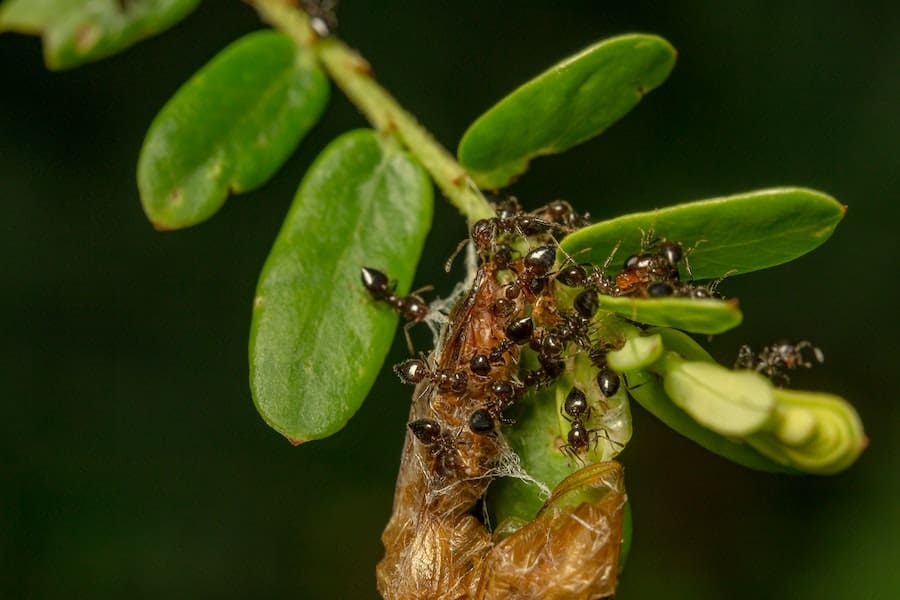Finding ants in your car can be a perplexing and frustrating experience, especially when you are sure there is no food left behind. These tiny creatures appear out of thin air, leaving you wondering how they are drawn to your vehicle despite the absence of any visible food source. Understanding the reasons behind this peculiar phenomenon requires delving into the intricate world of ant behavior and their keen ability to detect even the faintest traces of sustenance. In this article, we will unravel why ants invade cars without apparent food and explore preventive measures to keep these unwelcome guests at bay. Let’s dive into the fascinating world of ants and their intriguing invasion of our vehicles.
Why Are There Ants In My Car No Food?
Ants can end up in your car even when there’s no visible food because they have an exceptional ability to detect minute traces of sustenance. Food residue from previous trips or spills may have attracted them. Additionally, ants may seek water sources in your car, especially if there are leaks or moist areas. Sometimes, hidden food items can be the culprit; ants are remarkably adept at finding concealed sources. Moreover, habit and pheromone trails may lead them to explore your vehicle as a temporary shelter. To prevent ant invasions, regularly clean your car, address water leaks, and seal any openings that ants can exploit to gain entry.
What Attracts Ants To Cars In The Absence Of Any Visible Food?
Ants are highly resourceful and adaptive creatures with a remarkable ability to locate food sources, even in seemingly inhospitable environments like cars. In the absence of any visible food, several factors can still attract ants to vehicles:
Residual Food Odors: One of the primary reasons ants are drawn to cars without visible food is the presence of residual food odors. Even small crumbs, spills, or food particles left behind from snacks or meals can emit powerful scents that ants can detect. These odors can linger in various nooks and crannies of the car’s interior, such as between seats, cup holders, or under floor mats.
Previous Food Spills: If food spills have occurred in the past, it’s possible that they were not thoroughly cleaned, leaving behind traces of sugars, proteins, or other attractive substances. Ants have an acute sense of smell, and they can follow these faint trails, leading them straight to your car.
Organic Materials: Besides human food, ants are attracted to organic materials such as plant debris, fallen leaves, or pollen. If your car is parked under trees or in areas with vegetation, these materials may accumulate on or near your vehicle, enticing ants to explore.
Moisture: Ants need water to survive, and they are particularly attracted to sources of moisture. If your car has any water leaks or if you have spilled liquids, even water bottles or drink containers, it can create a damp environment that appeals to ants seeking hydration.
Environmental Factors: Ant activity can be influenced by environmental factors such as temperature and weather conditions. During hot weather, ants may seek more excellent areas like the interior of a parked car. In colder climates, some ant species may look for warmth inside the vehicle.
Pheromone Trails: Ants leave pheromone trails to communicate with other colony members. These trails act as guides, directing other ants to potential food sources. If an ant previously found food in your car and left a pheromone trail behind, it can attract more ants even when the food is no longer present.
Secondary Food Sources: In the absence of typical human food, ants may explore and feed on alternative organic materials in the car, such as crumbs from dried leaves, dead insects, or food wrappers.
Shelter and Warmth: Cars can offer ants a sheltered, secure space, especially in extreme weather conditions. Ants might use the vehicle’s interior as temporary nesting sites or as a warm refuge.
How Do Ants Adapt Their Foraging Behavior To Find Alternative Food?
Ants are highly adaptable creatures, demonstrating remarkable flexibility in their foraging behavior when faced with a scarcity of their usual food sources. When traditional food options are limited or unavailable, ants employ several strategies to find alternative food:
Exploratory Behavior:
Ants are curious by nature, and when their typical food sources are scarce, they become more exploratory in their foraging behavior. They venture out into more expansive areas, seeking out new food options and potential resources.
Switching Food Preferences:
Ants have a diverse diet and can adjust their food preferences based on availability. While they may primarily be attracted to sweet substances, when sugar sources are scarce, they readily shift to consuming proteins, fats, or even plant-based materials.
Opportunistic Feeding:
Ants are opportunistic feeders, and they seize upon any available food source. This could include scavenging on decaying organic matter, dead insects, or fallen fruits and seeds.
Utilizing Plant Exudates:
Some ants have mutualistic relationships with plants, where they “milk” sugary secretions called exudates from aphids or other insects. When food is limited, ants may increase their interactions with such insects to access these sweet exudates.
Raiding Behavior:
Certain ant species adopt raiding behavior, where they actively seek out and attack other insect colonies to steal their food and resources. This aggressive tactic allows them to secure food when their regular sources are insufficient.
Scavenging from Human Habitations:
Urban-dwelling ants, such as pavement ants and pharaoh ants, have become adept at scavenging in human habitats. They may exploit discarded food, crumbs, or leftovers in and around buildings and trash cans.
Exploiting Human-Induced Environments:
Ants adapt to human-induced environments, such as agricultural fields, gardens, and urban landscapes, where they can find alternative food sources like spilled pet food, bird feeders, or compost piles.
Seasonal Foraging:
Ants may exhibit seasonal variations in their foraging behavior, capitalizing on different food sources available in various seasons. For instance, they may feed on blooming flowers or fallen fruits during certain times of the year.
Tips For Preventing Ant Infestations In Cars
Preventing ant infestations in cars requires a combination of proactive measures and regular maintenance. By following these tips, you can significantly reduce the likelihood of ants invading your vehicle:
- Regularly clean your car’s interior, removing any food particles, crumbs, or spills that could attract ants. Vacuum the seats, floor mats, and crevices where debris might accumulate. A clean car provides fewer incentives for ants to explore.
- If you carry food items in your car, store them in airtight containers to prevent odors from attracting ants. Also, consider using a cooler or insulated bag to keep perishable food fresh and contained.
- Seal any openings or gaps in the car’s exterior that ants could use to gain entry. Pay attention to gaps around windows, doors, and vents. Weatherstripping or silicone caulk can help seal potential entry points.
- Employ natural ant repellents to deter ants from entering your car. Ants dislike certain smells, such as vinegar, cinnamon, peppermint, or citrus. Placing cotton balls soaked in these scents or using essential oil sprays can be effective repellents.
How Do Ants Communicate And Coordinate Their Activities?
Ants communicate and coordinate their activities through a sophisticated system of chemical signals and physical interactions. Their ability to work together as a cohesive unit is a remarkable example of social organization. The primary methods of communication and coordination in ants include:
Ants release chemical substances called pheromones to communicate with one another. These pheromones are secreted from various glands on their bodies and serve as mighty messengers to convey information about food sources, danger, or the location of their nests.
When ants find a food source, they lay down a trail of pheromones as they return to the colony. This trail acts as a guide for other ants to follow and leads them directly to the food. The more ants that follow the trail, the stronger the scent becomes, reinforcing the path and attracting even more ants.
When an ant discovers a valuable food source, it will recruit other ants to help exploit it. It uses a specialized behavior known as “tandem running.” The recruiting will lead another and back to the food source while releasing recruitment pheromones. Once the second ant is familiar with the route, it will return to the colony and recruit more ants, continuing the process until a steady stream of workers is moving to and from the food.
When an ant perceives a threat or danger, it emits alarm pheromones to alert nearby colony members. This signal triggers a defensive response, and ants may rush to attack or evacuate the area to protect the colony.
Ants use their antennae to touch and feel one another, which aids in exchanging information. This physical contact allows ants to assess each other’s condition, communicate about their intentions, and reinforce social bonds.
As mentioned, ants run in tandem to guide nestmates to new food sources. One ant leads the way while the follower touches the leader’s abdomen with its antennae to sense the pheromones left on the trail.
Ants engage in trophallaxis, exchanging liquid food and regurgitating it from their mouth to another ant’s mouth. This behavior helps distribute food and allows information about available resources to be shared among colony members.
Final Words
Ants are fascinating creatures with a highly developed system of communication and coordination. Their ability to work together as a unified community is genuinely awe-inspiring. Through pheromones, trail marking, recruitment behaviors, and physical interactions, ants can efficiently share vital information about food sources, danger, and the location of their nests. To keep ants away from your car, remember to maintain cleanliness, avoid eating inside the vehicle, store food properly, and promptly address any water leaks. Additionally, using natural ant repellents and parking in well-maintained areas can discourage ants from approaching your car.
FAQ’s
Q: Why are there ants in my car even when there’s no visible food?
A: Ants are highly adept at detecting even the faintest traces of food. Residual food odors from previous spills or snacks, hidden food sources, and moisture in the car can attract ants. Additionally, ants may use the vehicle for shelter or follow pheromone trails left by other ants that previously found food inside the car.
Q: How do ants communicate and coordinate their activities?
A: Ants communicate through chemical signals called pheromones and physical interactions like antennation and trophallaxis. Trail pheromones help ants mark paths to food sources, while alarm pheromones alert the colony to potential threats. Ants use tandem running to recruit nestmates to new food sources and work together efficiently as a cohesive unit.
Q: How can I prevent ant infestations in my car?
A: To prevent ant infestations, keep your car clean and free of food particles, spills, and crumbs. Avoid eating inside the car and store food properly in airtight containers. Regularly check for water leaks and seal any openings that ants could use to enter the vehicle. Use natural ant repellents and be mindful of where you park your car, avoiding ant-prone areas.




















Leave a Reply